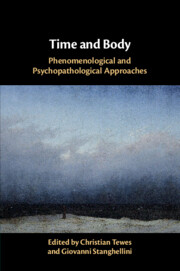Book contents
- Time and Body
- Endorsements for Time and Body
- Time and Body
- Copyright page
- Dedication
- Additional material
- Contents
- Figures
- Contributors
- 1 Introduction – Time and Body
- 2 Time, the Body, and the Other in Phenomenology and Psychopathology
- Part I Body and Time: General Aspects
- 3 The Body – Another
- 3.1 Commentary on “The Body – Another: Phenomenological and Psychoanalytic Perspectives”
- 4 The Heart of Darkness of the Living Body
- 4.1 Commentary on “The Heart of Darkness of the Living Body”
- 5 Microphenomenology of Chronicity in Psychosomatic Diseases
- 5.1 Commentary on “Microphenomenology of Chronicity in Psychosomatic Diseases: Diabetes, Anorexia, and Schizophrenia”
- 6 Time and Embodiment in the Process of Psychotherapy: A Dynamical Systems Perspective
- 6.1 Commentary on “Time and Embodiment in the Process of Psychotherapy: A Dynamical Systems Perspective”The Musicality of Human Interaction
- Part II Grief and Anxiety
- Part III Borderline Personality and Eating Disorders
- Part IV Depression, Schizophrenia, and Dementia
- Index
- References
3.1 - Commentary on “The Body – Another: Phenomenological and Psychoanalytic Perspectives”
Phenomenology and Psychoanalysis: Disruptive Speech in the Realm of the Flesh
from Part I - Body and Time: General Aspects
Published online by Cambridge University Press: 30 October 2020
- Time and Body
- Endorsements for Time and Body
- Time and Body
- Copyright page
- Dedication
- Additional material
- Contents
- Figures
- Contributors
- 1 Introduction – Time and Body
- 2 Time, the Body, and the Other in Phenomenology and Psychopathology
- Part I Body and Time: General Aspects
- 3 The Body – Another
- 3.1 Commentary on “The Body – Another: Phenomenological and Psychoanalytic Perspectives”
- 4 The Heart of Darkness of the Living Body
- 4.1 Commentary on “The Heart of Darkness of the Living Body”
- 5 Microphenomenology of Chronicity in Psychosomatic Diseases
- 5.1 Commentary on “Microphenomenology of Chronicity in Psychosomatic Diseases: Diabetes, Anorexia, and Schizophrenia”
- 6 Time and Embodiment in the Process of Psychotherapy: A Dynamical Systems Perspective
- 6.1 Commentary on “Time and Embodiment in the Process of Psychotherapy: A Dynamical Systems Perspective”The Musicality of Human Interaction
- Part II Grief and Anxiety
- Part III Borderline Personality and Eating Disorders
- Part IV Depression, Schizophrenia, and Dementia
- Index
- References
Summary
The question of the most rigorous and best-grounded philosophical basis for psychoanalytical experience is a serious question, not simply because psychoanalysis became the most influential current in psychotherapy during the last century but also because it is the only current trying to offer an interpretation of what happens in the deeper layers of our affective life. This is why philosophers in the phenomenological tradition have had difficulties in their approach to psychodynamics: The psychoanalytic attention to depth entails a more or less speculative approach to interpretation, because of what it sees as the hidden aspects of the psyche.
- Type
- Chapter
- Information
- Time and BodyPhenomenological and Psychopathological Approaches, pp. 55 - 59Publisher: Cambridge University PressPrint publication year: 2020

